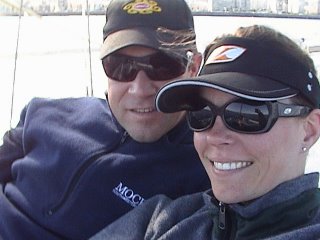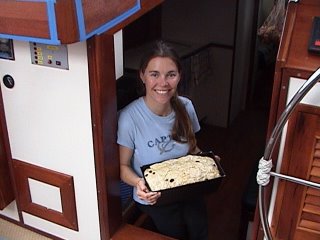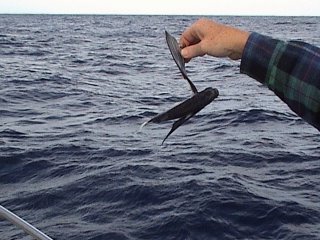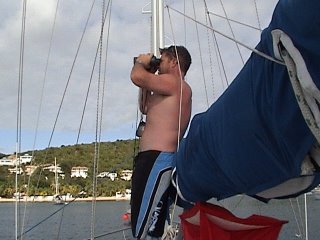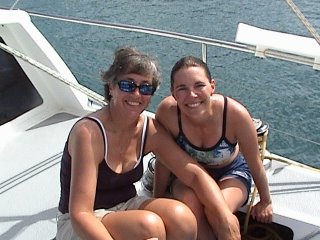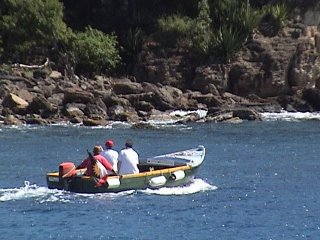Our original departure date was pushed back more than three times. Originally we planned to leave right after the New Year, January 4, 2006 , but due to weather delays we postponed. We expected to depart the following Monday, January 9, but also weather postponed us. At the same time the little head cold that was floating from boat to boat on the dock made it aboard the crew of Quest. Jeff and I were under the weather for a while, Jeff’s cold lasted two weeks and mine just a few days. But needless to say one should not depart for a 3 week excursion across the high seas whilst under the weather. We geared up to depart again after the weather had passed on Thursday, January 12, 2006 . We actually untied the dock lines, put the engine in reverse and wouldn’t you know we had the mooring line wrap the starboard propeller. Jeff was dressed in his swim trunks and mask in less than two minutes and jumped in to unravel the line.
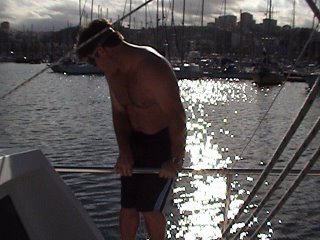
He showered off and we were back to getting underway. We got the boat off the dock and motored to the fuel dock for the last top off on the diesel tanks. While we were heading over Chris was noticing that the starboard engine was not engaging to forward nor reverse. When we reached the fuel dock Jeff redressed in his swim trunks and mask, jumped back into the water to see if the sail drive was damaged when the line wrapped the propeller. Once the realization had hit us that the engine had some damage, Jeff showered with the hose at the fuel dock; we motored with the port engine back to our berth on pontoon 18. So many things were going through our heads as to what type of damage, what type of repair might be necessary to get the engine going again. Would we need to haul out and have Quest up on the hard for it to be repaired? What time frame were we looking at? Something that could take a week, a month, depending on the yard, do they have space for us, when could we get underway? Needless to say we were stressing especially since we were really excited to get underway across the
On Friday, January 13, 2006 at 1530 we released the dock lines and started our trip across the Atlantic .
Days 1 - 7
We moved north around the island of Las Palmas Tenerife with its view of a snow covered volcano and eventually we passed the western most islands in the Canary Islands named Gomera and Hierro.
Our first few days seemed full of wind from the east and we were moving along at 170 nautical miles a day. We were visited by a pod of dolphins.
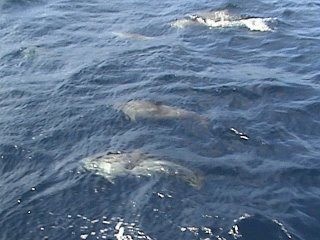
Even though it seemed encouraging, the breeze did not maintain its velocity and we began to experience doldrums. We kept moving with the breeze but it brought us south and not west. The prayer from each of the crew when crossing the
After dinner Jeff and Chris went to jibe the sail from starboard to port, all was going smoothly when mainsail was being let out on the port side and the wind spiked enough to explode the mainsail and send a tear like a lightening bolt from the head of the sail to the leech. The jagged tear did nothing to lift our spirits since we knew that attempting a repair like this would be tough. Many sailboats have additional sails, Quest does not. The inventory for Quest is one genoa, one asymmetrical spinnaker, a storm jib, and now an exploded mainsail. We were left to sail the remainder of our journey on the jibs alone. Thankfully the genoa is a beefy sail and with strong winds of 13 – 20 knots we could really make some time. The asymmetrical spinnaker sails well in 8 – 15 knots, and the storm jib is only good for 25 knots and up. But again we are sailing, wind is the hot commodity and we were in need of some.
Jeff started to troll with his hand real and we were lucky to have a yellow fin tuna for lunch and dinner. We had sashimi for lunch. Dinner we had two types of tuna. Asian style tuna pan seared with ginger, soy, wasabi and vinegar dressing. We also had twist of “Cat Fish” style tuna with a spicy breading lightly fried in olive oil. Both were served with white rice and a sprinkle of black sesame seeds. It was brilliant!
I baked some bread too!
Days 8 – 15
While sailing across the Atlantic and other oceans boat usually have an “SSB” (Single Side Band) radio aboard. The SSB is a great way for a vessel to keep in touch with other boats that are heading in the same direction. The group is called a “Net.” The “Net” decides on a frequency and time of day usually every 12 hours to check in and communicate. In our “Net” we had total of 5 boats. Calypso, Argentaria, and Altalia had departed 48 hours ahead of us. Gilana had departed 24 hours ahead. The “net” is very helpful with discussing upcoming weather information, passing on well wishes and just important information like latitude and longitude positions so in case anything happens like an EPIRB is set off there is a record of where you last checked in. The boats 2 days ahead are closer than one 6 days off.
During our morning “Net” the boat furthest west Argentaria told our group about an EPIRB that the Portuguese Airforce was responding to. While sailing the night before the Portuguese Airforce plane had circled above Argentaria and notified them by VHF (Very High Frequency) radio of the position of the EPIRB signal and asked Argentaria to divert their course to the area of the EPIRB and provide assistance. Argentaria did not know what type of vessel was in distress, but as a group we all changed our direction to head for this EPIRB to assist. Argentaria was the first vessel to arrive and pulled a life raft alongside and inside were two weary Atlantic Row Boat Crossing competitors. Just a few weeks earlier the Atlantic Row Boat Crossing Regatta began from Las Palmas
With the rescue taken care of we were able to get back on our original course.
On the evening of the 10th day out to sea Jeff had the 2000 – 2300 shift. It was an exceptionally dark night, no moon and still as a lake in the middle of the Atlantic . Jeff had his head out of the pilot house and he saw a green flair to the north of us that arced out across the sky. Distress flairs are red in color, however this was green and he said it lit up the whole sky. We did divert our course and motored 10 miles to the north and made communication on the VHF radio if any other vessels in the area either saw or may have deployed it and need assistance. After no response and checking the line of sight area we decided to call it chance or perhaps a meteor, but we went back to our course.
A few days later Calypso spoke on the morning “Net” about seeing a similar arcing green flair that lit up the whole sky. It was not determined what it was, but it was seen a second time on another night. Hummm….makes one wonder.
Day 11 brought us whales! We spent the morning setting the asymmetrical spinnaker with the pole. Of course it was a beautiful day, light breeze, sunshine and whales everywhere. We tried to take photos of them with the still camera, but they are shy and would only get caught in the video footage. We also noticed what looked like small algae floating by when all of a sudden we were smack in the middle of a huge ocean current. The current was at least to boat widths wide. We could tell it was current with all the stuff floating in it, especially the plastic netting which seemed to be all over the water. It was a sad sight to see plastic bags, a shoe, just downright junk in the middle of the Atlantic .
Each day we are out here we see a bird. It is white with a longer tail. After speaking to Gilana we found out the bird’s name is the Tropic Bird. We are thousands of miles from land and this bird just floats over head like land is right around the corner!
We had the pleasure of seeing the flying fish out here in the Atlantic . It is a sight to see what one might think is a bird with wings flying so close to the water, but it is not, it is a fish with wings sailing through the water away from its prey. We check the deck daily for flying fish that did not make it passed Quest. We have returned at least 6 stiff ones that fly themselves on the deck or get washed on by the waves and are unable to return to their watery homes.
Okay, we told everyone that our trip across the Atlantic should take about 18 days when the trade winds are really working. Well this January is not typical in the statistic books for Mid Atlantic trade winds. We have had everything but. Day 14 gave us flat calm and we had to motor for 24 hours. Day 15 began with little breeze and a lot of sun. Jeff and I took advantage and gave ourselves a salt water wash on deck with a bucket. One would think the middle of the Atlantic might be chilly, not the southern Mid Atlantic. The water is about 80 degrees Fahrenheit.
Low pressure systems were to the west of us, right where we want to go. Having a low pressure pushing down on us causes the wind to shut off until we sail in the middle of it and we reap the benefits of the wind but also the havoc the seas. We ended up getting some serious waves of 15 – 18 feet and winds from 18 – 30 knots. Originally we battened down all the hatches and lashed as much as we could down. Unfortunately we took for granted a key piece of equipment: the biminy (sunshade). We had been in strong winds before, but these were different, they were from the Northwest and they came with a vengeance. We watched as the shade slowly ripped from the starboard side to them middle with the 30 knot gusts. Chris wanted to just cut it all down so that we would not lose the stainless frame with the wind. So we harnessed up and went out with sharp knives and cut the whole thing down. It was a shame we forgot to close up the whole frame in the first place, it was a great biminy and gave Jeff and I many days of cool shade!
The waves took their toll on Quest that evening. When we surveyed the damage in the morning light we had lost a 5 gallon jury jug of water. It was strapped to the stern of the cockpit. The waves were strong enough to break through two lines and a Velcro strap for the jug.
Needless to say that being on the open ocean is not for everyone. Face it, sea sickness can really make a not so nice time even worse. Thankfully we have only had one of our crew, Louise, afflicted with the tormenting likes of this problem. We managed to change meal preparation tasks to help out our mate and keep her out of the hot kitchen which makes her feel even worse. The sickness happens to Louise when the seas are rolling and she has a hard time keeping her eyes on the horizon.
Days 16 – 20
We finally got wind along with big seas, but over the last few days it smoothed over and we were sailing 7 knots toward Antigua . The last few days seemed to take forever until we finally saw land! It was like a grey outline on the horizon. As we arrived closer we got to see the beauty of the island. Green hills, beautiful rock formations, blue green water, it was truly a sight. The island was discovered by Columbus church of Santa Maria Antigua in Seville , Spain Antigua is an independent island.
We spotted land at 0800. Jeff and I spent most of the morning outside in anticipation of land fall. We arrived in English Harbor Pillars of Hercules boarder the port entrance, they are a prime example of the history of the island. We arrived at anchorage at 1335, a total of 20 days and 2 hours to the minute!
